A Model-Assisted Probability of Detection Framework for Optical Fiber Sensors
Abstract
:1. Introduction
2. Materials and Methods
2.1. MAPOD Concept for DOFSs
2.2. Strain Transfer
2.3. Interrogator Resolution
2.4. Human Factors
2.4.1. Hot-Touch Error
2.4.2. Bonding Error
2.5. Environmental Noise
3. The DCB Case Study
3.1. Experimental Setup
3.2. DCB Parametric Model
3.3. Delamination Modeling from a MAPOD Perspective
4. Results
4.1. Model Validation
4.1.1. Length at Detection Method and MAPOD Curve
4.2. Sensitivity Analysis
4.2.1. Noise Effect (Case 1)
4.2.2. Strain Transfer Effect (Case 2)
4.2.3. Interrogator Resolution Effect (Case 3)
4.2.4. Hot-Touch Error Effect (Case 4)
4.2.5. Bonding Error Effect (Case 5)
5. Discussion
Upscaling of the MAPOD Methodology to a Real Aerospace Structure
6. Conclusions
Author Contributions
Funding
Institutional Review Board Statement
Informed Consent Statement
Data Availability Statement
Conflicts of Interest
References
- Guo, H.; Xiao, G.; Mrad, N.; Yao, J. Fiber Optic Sensors for Structural Health Monitoring of Air Platforms. Sensors 2011, 11, 3687–3705. [Google Scholar] [CrossRef]
- Glišić, B.; Inaudi, D. Fibre Optic Methods for Structural Health Monitoring; John Wiley & Sons: Chichester, UK; Hoboken, NJ, USA, 2007; ISBN 978-0-470-06142-8. [Google Scholar]
- Güemes, A.; Fernández-López, A.; Díaz-Maroto, P.; Lozano, A.; Sierra-Perez, J. Structural Health Monitoring in Composite Structures by Fiber-Optic Sensors. Sensors 2018, 18, 1094. [Google Scholar] [CrossRef]
- Rufai, O.; Chandarana, N.; Gautam, M.; Potluri, P.; Gresil, M. Cure Monitoring and Structural Health Monitoring of Composites Using Micro-Braided Distributed Optical Fibre. Compos. Struct. 2020, 254, 112861. [Google Scholar] [CrossRef]
- Falcetelli, F.; Di Sante, R.; Troiani, E. Strategies for Embedding Optical Fiber Sensors in Additive Manufacturing Structures. In European Workshop on Structural Health Monitoring; Rizzo, P., Milazzo, A., Eds.; Lecture Notes in Civil Engineering; Springer International Publishing: Cham, Switzerland, 2021; Volume 128, pp. 362–371. ISBN 978-3-030-64908-1. [Google Scholar]
- Kashyap, R. Fiber Bragg Gratings, 2nd ed.; Academic Press: Burlington, MA, USA, 2010; ISBN 978-0-12-372579-0. [Google Scholar]
- Cusano, A.; Cutolo, A.; Albert, J. (Eds.) Fiber Bragg Grating Sensors: Recent Advancements, Industrial Applications and Market Exploitation; Bentham Science Publishers: Sharjah, United Arab Emirates, 2012; ISBN 978-1-60805-084-0. [Google Scholar]
- Lu, P.; Lalam, N.; Badar, M.; Liu, B.; Chorpening, B.T.; Buric, M.P.; Ohodnicki, P.R. Distributed Optical Fiber Sensing: Review and Perspective. Appl. Phys. Rev. 2019, 6, 041302. [Google Scholar] [CrossRef]
- Palmieri, L.; Schenato, L.; Santagiustina, M.; Galtarossa, A. Rayleigh-Based Distributed Optical Fiber Sensing. Sensors 2022, 22, 6811. [Google Scholar] [CrossRef]
- Cawley, P. Structural Health Monitoring: Closing the Gap between Research and Industrial Deployment. Struct. Health Monit. 2018, 17, 1225–1244. [Google Scholar] [CrossRef]
- Falcetelli, F.; Yue, N.; Di Sante, R.; Zarouchas, D. Probability of Detection, Localization, and Sizing: The Evolution of Reliability Metrics in Structural Health Monitoring. Struct. Health Monit. 2022, 21, 2990–3017. [Google Scholar] [CrossRef]
- Department of Defense Handbook: Nondestructive Evaluation System Reliability Assessment; Department of Defense: Washington, DC, USA, 2009.
- Schubert Kabban, C.M.; Greenwell, B.M.; DeSimio, M.P.; Derriso, M.M. The Probability of Detection for Structural Health Monitoring Systems: Repeated Measures Data. Struct. Health Monit. 2015, 14, 252–264. [Google Scholar] [CrossRef]
- Janapati, V.; Kopsaftopoulos, F.; Li, F.; Lee, S.J.; Chang, F.-K. Damage Detection Sensitivity Characterization of Acousto-Ultrasound-Based Structural Health Monitoring Techniques. Struct. Health Monit. 2016, 15, 143–161. [Google Scholar] [CrossRef]
- Meeker, W.Q.; Roach, D.; Kessler, S.S. Statistical Methods for Probability of Detection in Structural Health Monitoring. In Proceedings of the Structural Health Monitoring 2019, Stanford, CA, USA, 10–12 September 2019; DEStech Publications, Inc.: Stanford, CA, USA. [Google Scholar]
- Kessler, S.S.; Dunn, C.T.; Swindell, P.; Meeker, W. Detection Sensitivity Analysis for a Potential Drop (PD) Structural Health Monitoring (SHM) System. In Proceedings of the 12th International Workshop on Structural Health Monitoring, Stanford, CA, USA, 10–12 September 2019; DEStech Publications, Inc.: Stanford, CA, USA. [Google Scholar]
- Falcetelli, F.; Cristiani, D.; Yue, N.; Sbarufatti, C.; Troiani, E.; Di Sante, R.; Zarouchas, D. Qualification of Distributed Optical Fiber Sensors Using Probability of Detection Curves for Delamination in Composite Laminates. Struct. Health Monit. 2022, 147592172211411. [Google Scholar] [CrossRef]
- Thompson, R.B.; Thompson, D.O.; Chimenti, D.E. A Unified Approach to the Model-Assisted Determination of Probability of Detection. In Proceedings of the AIP Conference Proceedings, Golden, CO, USA, 22–27 July 2007; AIP: Golden, CO, USA, 2008; Volume 975, pp. 1685–1692. [Google Scholar]
- Aldrin, J.C.; Knopp, J.S.; Lindgren, E.A.; Jata, K.V.; Thompson, D.O.; Chimenti, D.E. Model-Assisted Probability of Detection Evaluation for Eddy Current Inspection of Fastener Sites. In Proceedings of the AIP Conference Proceedings, Chicago, IL, USA, 20–25 July 2008; AIP: Chicago, IL, USA, 2009; pp. 1784–1791. [Google Scholar]
- Thompson, R.B.; Brasche, L.J.; Forsyth, D.; Lindgren, E.A.; Swindell, P.; Winfree, W. Recent Advances in Model-Assisted Probability of Detection; NDT.net: Berlin, Germany, 2009. [Google Scholar]
- Foucher, F.; Fernandez, R.; Leberre, S.; Calmon, P. New Tools in CIVA for Model Assisted Probability of Detection (MAPOD) to Support NDE Reliability Studies; ASNT: Bridgeton, MO, USA, 2018; p. 12. [Google Scholar]
- Foucher, M.F.; Lonne, S.; Toullelan, G.; Mahaut, S.; Chatillon, S. An Overview of Validation Campaigns of the CIVA Simulation Software; NDT.net: Gothenburg, Sweden, 2018; p. 9. [Google Scholar]
- Aldrin, J.C.; Medina, E.A.; Lindgren, E.A.; Buynak, C.F.; Knopp, J.S. Protocol for Reliability Assessment of Structural Health Monitoring Systems Incorporating Model-Assisted Probability of Detection (MAPOD) Approach. In Proceedings of the 8th International Workshop on Structural Health Monitoring, Stanford, CA, USA, 13 September 2011; pp. 2452–2459. [Google Scholar]
- Tschoke, K.; Mueller, I.; Memmolo, V.; Moix-Bonet, M.; Moll, J.; Lugovtsova, Y.; Golub, M.; Venkat, R.S.; Schubert, L. Feasibility of Model-Assisted Probability of Detection Principles for Structural Health Monitoring Systems Based on Guided Waves for Fibre-Reinforced Composites. IEEE Trans. Ultrason. Ferroelect. Freq. Contr. 2021, 68, 3156–3173. [Google Scholar] [CrossRef] [PubMed]
- Moriot, J.; Quaegebeur, N.; Le Duff, A.; Masson, P. A Model-Based Approach for Statistical Assessment of Detection and Localization Performance of Guided Wave–Based Imaging Techniques. Struct. Health Monit. 2018, 17, 1460–1472. [Google Scholar] [CrossRef]
- Leung, M.S.H.; Corcoran, J. Evaluating the Probability of Detection Capability of Permanently Installed Sensors Using a Structural Integrity Informed Approach. J. Nondestruct. Eval. 2021, 40, 82. [Google Scholar] [CrossRef]
- Falcetelli, F.; Venturini, N.; Romero, M.B.; Martinez, M.J.; Pant, S.; Troiani, E. Broadband Signal Reconstruction for SHM: An Experimental and Numerical Time Reversal Methodology. J. Intell. Mater. Syst. Struct. 2021, 32, 1043–1058. [Google Scholar] [CrossRef]
- Gagar, D.; Irving, P.E.; Jennions, I.K.; Foote, P.; Read, I.; McFeat, J. Development of Probability of Detection Data for Structural Health Monitoring Damage Detection Techniques Based on Acoustic Emission. In Proceedings of the 8th International Workshop on Structural Heath Monitoring, Stanford, CA, USA, 13 September 2011; pp. 1391–1398. [Google Scholar]
- Falcetelli, F.; Barroso-Romero, M.; Pant, S.; Troiani, E.; Martinez, M. Modelling of Pencil-Lead Break Acoustic Emission Sources Using the Time Reversal Technique. In Proceedings of the EWSHM 2018, Manchester, UK, 10–13 July 2018; NDT.net: Manchester, UK, 2018. [Google Scholar]
- Sbarufatti, C.; Giglio, M. Performance Qualification of an On-Board Model-Based Diagnostic System for Fatigue Crack Monitoring. J. Am. Helicopter Soc. 2017, 62, 1–10. [Google Scholar] [CrossRef]
- Sbarufatti, C.; Corbetta, M.; San Millan, J.; Frovel, M.; Stefaniuk, M.; Giglio, M. Model-Assisted Performance Qualification of a Distributed SHM System for Fatigue Crack Detection on a Helicopter Tail Boom. In Proceedings of the EWSHM 2016, Bilbao, Spain, 5 July 2016. [Google Scholar]
- Lima, R.A.A.; Migliavacca, F.; Martulli, L.M.; Carboni, M.; Bernasconi, A. Distributed Fibre Optic Monitoring of Mode I Fatigue Crack Propagation in Adhesive Bonded Joints and Comparison with Digital Image Correlation. Theor. Appl. Fract. Mech. 2022, 121, 103501. [Google Scholar] [CrossRef]
- Stutz, S.; Cugnoni, J.; Botsis, J. Studies of Mode I Delamination in Monotonic and Fatigue Loading Using FBG Wavelength Multiplexing and Numerical Analysis. Compos. Sci. Technol. 2011, 71, 443–449. [Google Scholar] [CrossRef]
- Falcetelli, F.; Rossi, L.; Di Sante, R.; Bolognini, G. Strain Transfer in Surface-Bonded Optical Fiber Sensors. Sensors 2020, 20, 3100. [Google Scholar] [CrossRef]
- Ansari, F.; Libo, Y. Mechanics of Bond and Interface Shear Transfer in Optical Fiber Sensors. J. Eng. Mech. 1998, 124, 385–394. [Google Scholar] [CrossRef]
- Yan, M.; Tan, X.; Mahjoubi, S.; Bao, Y. Strain Transfer Effect on Measurements with Distributed Fiber Optic Sensors. Autom. Constr. 2022, 139, 104262. [Google Scholar] [CrossRef]
- Mueller, C.; Bertovic, M.; Pavlovic, M.; Kanzler, D.; Ewert, U.; Pitkänen, J.; Ronneteg, U. Paradigm Shift in the Holistic Evaluation of the Reliability of NDE Systems. Mater. Test. 2013, 55, 261–269. [Google Scholar] [CrossRef]
- Li, H.-N.; Zhou, G.-D.; Ren, L.; Li, D.-S. Strain Transfer Coefficient Analyses for Embedded Fiber Bragg Grating Sensors in Different Host Materials. J. Eng. Mech. 2009, 135, 1343–1353. [Google Scholar] [CrossRef]
- Li, D.-S.; Li, H.; Ren, L.; Song, G. Strain Transferring Analysis of Fiber Bragg Grating Sensors. Opt. Eng. 2006, 45, 024402. [Google Scholar] [CrossRef]
- Her, S.-C.; Huang, C.-Y. Effect of Coating on the Strain Transfer of Optical Fiber Sensors. Sensors 2011, 11, 6926–6941. [Google Scholar] [CrossRef] [PubMed]
- Wang, H.; Xiang, P.; Jiang, L. Strain Transfer Theory of Industrialized Optical Fiber-Based Sensors in Civil Engineering: A Review on Measurement Accuracy, Design and Calibration. Sens. Actuators A Phys. 2019, 285, 414–426. [Google Scholar] [CrossRef]
- Billon, A.; Hénault, J.-M.; Quiertant, M.; Taillade, F.; Khadour, A.; Martin, R.-P.; Benzarti, K. Qualification of a Distributed Optical Fiber Sensor Bonded to the Surface of a Concrete Structure: A Methodology to Obtain Quantitative Strain Measurements. Smart Mater. Struct. 2015, 24, 115001. [Google Scholar] [CrossRef]
- D30 Committee Test Method for Mode I Interlaminar Fracture Toughness of Unidirectional Fiber-Reinforced Polymer Matrix Composites; ASTM International Headquarter: West Conshohocken, PA, USA.
- Hexcel HexPly® 8552 UD Carbon Prepregs. Available online: https://www.hexcel.com/user_area/content_media/raw/HexPly_8552_eu_DataSheet.pdf (accessed on 3 February 2022).
- FBGS Technologies GmbH ORMOCER® Coating. Available online: https://fbgs.com/technology/ormocer-coating/ (accessed on 4 February 2022).
- Product Information—TB1742. Available online: https://threebond-europe.com/products/tb1742/ (accessed on 4 February 2022).
- Optical Distributed Sensor Interrogator Model ODiSI-B: User’s Guide; Luna Innovations Inc.: Roanoke, VA, USA, 2017.
- Gifford, D.K.; Kreger, S.T.; Sang, A.K.; Froggatt, M.E.; Duncan, R.G.; Wolfe, M.S.; Soller, B.J. Swept-Wavelength Interferometric Interrogation of Fiber Rayleigh Scatter for Distributed Sensing Applications. In Proceedings of the Fiber Optic Sensors and Applications V, Boston, MA, USA, 12 October 2007; International Society for Optics and Photonics: Boston, MA, USA, 2007; Volume 6770, p. 67700F. [Google Scholar]
- Soller, B.J.; Wolfe, M.S.; Froggatt, M.E. Polarization Resolved Measurement of Rayleigh Backscatter in Fiber-Optic Components. In Proceedings of the OFC Technical Digest, Anaheim, CA, USA, 6 March 2005; OSA Publishing: Anaheim, CA, USA, 2005. [Google Scholar]
- Kreger, S.T.; Gifford, D.K.; Froggatt, M.E.; Soller, B.J.; Wolfe, M.S. High Resolution Distributed Strain or Temperature Measurements in Single- and Multi-Mode Fiber Using Swept-Wavelength Interferometry. In Proceedings of the Optical Fiber Sensors, Cancún, Mexico, 23–27 October 2006; OSA: Cancún, Mexico, 2006; p. ThE42. [Google Scholar]
- Škec, L.; Alfano, G.; Jelenić, G. Enhanced Simple Beam Theory for Characterising Mode-I Fracture Resistance via a Double Cantilever Beam Test. Compos. Part B Eng. 2019, 167, 250–262. [Google Scholar] [CrossRef]
- Cristiani, D.; Sbarufatti, C.; Giglio, M. Damage Diagnosis and Prognosis in Composite Double Cantilever Beam Coupons by Particle Filtering and Surrogate Modelling. Struct. Health Monit. 2021, 20, 1030–1050. [Google Scholar] [CrossRef]
- Truong, H.T.X.; Martinez, M.J.; Ochoa, O.O.; Lagoudas, D.C. Mode I Fracture Toughness of Hybrid Co-Cured Al-CFRP and NiTi-CFRP Interfaces: An Experimental and Computational Study. Compos. Part A Appl. Sci. Manuf. 2020, 135, 105925. [Google Scholar] [CrossRef]
- Roach, D. Real Time Crack Detection Using Mountable Comparative Vacuum Monitoring Sensors. Smart Struct. Syst. 2009, 5, 317–328. [Google Scholar] [CrossRef]
- Kralovec, C.; Schagerl, M. Review of Structural Health Monitoring Methods Regarding a Multi-Sensor Approach for Damage Assessment of Metal and Composite Structures. Sensors 2020, 20, 826. [Google Scholar] [CrossRef]
- Hall, D.L.; Llinas, J. An Introduction to Multisensor Data Fusion. Proc. IEEE 1997, 85, 6–23. [Google Scholar] [CrossRef]
- Cristiani, D.; Falcetelli, F.; Yue, N.; Sbarufatti, C.; Di Sante, R.; Zarouchas, D.; Giglio, M. Strain-Based Delamination Prediction in Fatigue Loaded CFRP Coupon Specimens by Deep Learning and Static Loading Data. Compos. Part B Eng. 2022, 241, 110020. [Google Scholar] [CrossRef]
- Ricci, F.; Monaco, E.; Boffa, N.D.; Maio, L.; Memmolo, V. Guided Waves for Structural Health Monitoring in Composites: A Review and Implementation Strategies. Prog. Aerosp. Sci. 2022, 129, 100790. [Google Scholar] [CrossRef]
- Ciminello, M.; Boffa, N.D.; Concilio, A.; Galasso, B.; Romano, F.; Monaco, E. Damage Detection of CFRP Stiffened Panels by Using Cross-Correlated Spatially Shifted Distributed Strain Sensors. Appl. Sci. 2020, 10, 2662. [Google Scholar] [CrossRef]
- Ciminello, M.; Concilio, A.; Galasso, B.; Pisano, F.M. Skin–Stringer Debonding Detection Using Distributed Dispersion Index Features. Struct. Health Monit. 2018, 17, 1245–1254. [Google Scholar] [CrossRef]
- Ciminello, M.; Sikorski, B.; Galasso, B.; Pellone, L.; Mercurio, U.; Concilio, A.; Apuleo, G.; Cozzolino, A.; Kressel, I.; Shoham, S.; et al. Preliminary Results of a Structural Health Monitoring System Application for Real-Time Debonding Detection on a Full-Scale Composite Spar. Sensors 2023, 23, 455. [Google Scholar] [CrossRef] [PubMed]
- Bisagni, C.; Brambilla, P.; Dávila, C.G. Modeling Delamination in Postbuckled Composite Structures under Static and Fatigue Loads; NASA: Washington, DC, USA, 2013; pp. 1035–1049.
- Raimondo, A.; Bisagni, C. Fatigue Analysis of a Post-Buckled Composite Single-Stringer Specimen Taking into Account the Local Stress Ratio. Compos. Part B Eng. 2020, 193, 108000. [Google Scholar] [CrossRef]
- Kootte, L.; Bisagni, C. A Methodology to Investigate Skin-Stringer Separation in Postbuckled Composite Stiffened Panels. In Proceedings of the AIAA Scitech 2020 Forum, Orlando, FL, USA, 6 January 2020; American Institute of Aeronautics and Astronautics: Orlando, FL, USA, 2020. [Google Scholar]

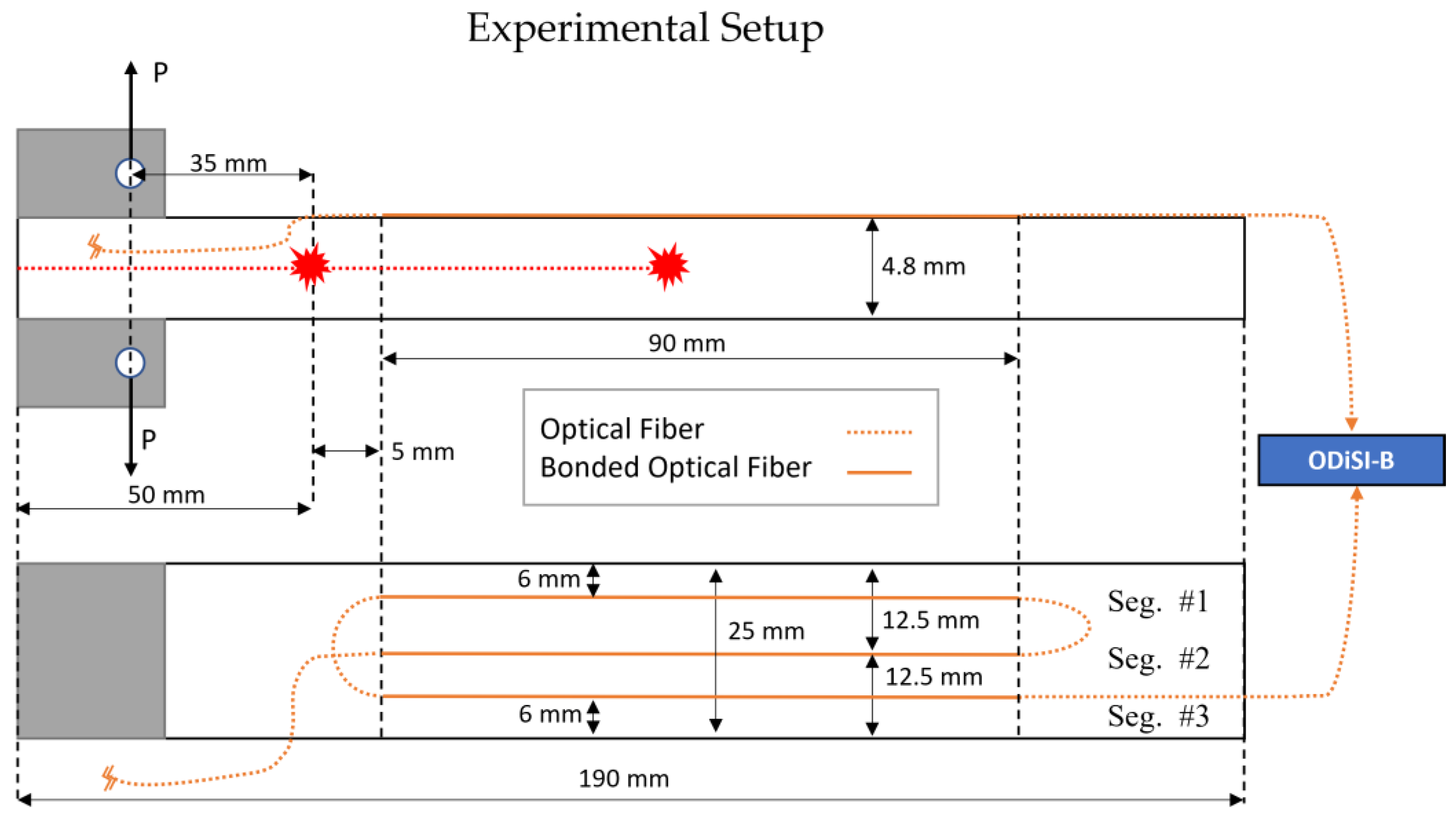


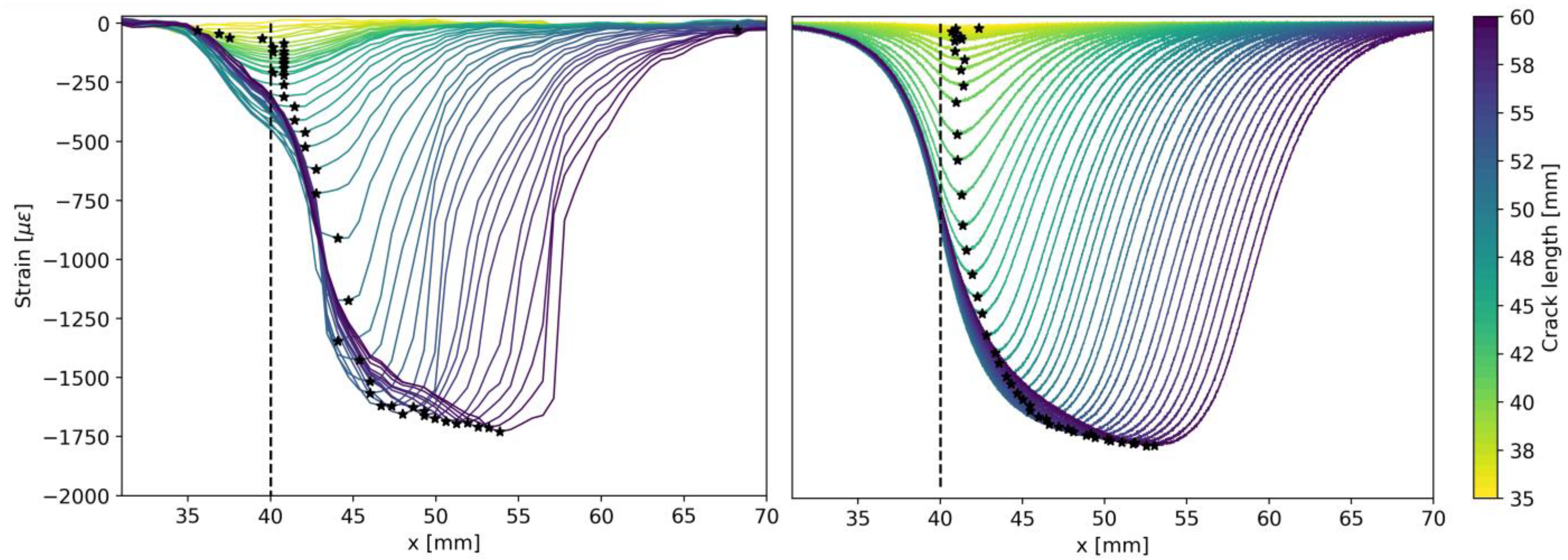

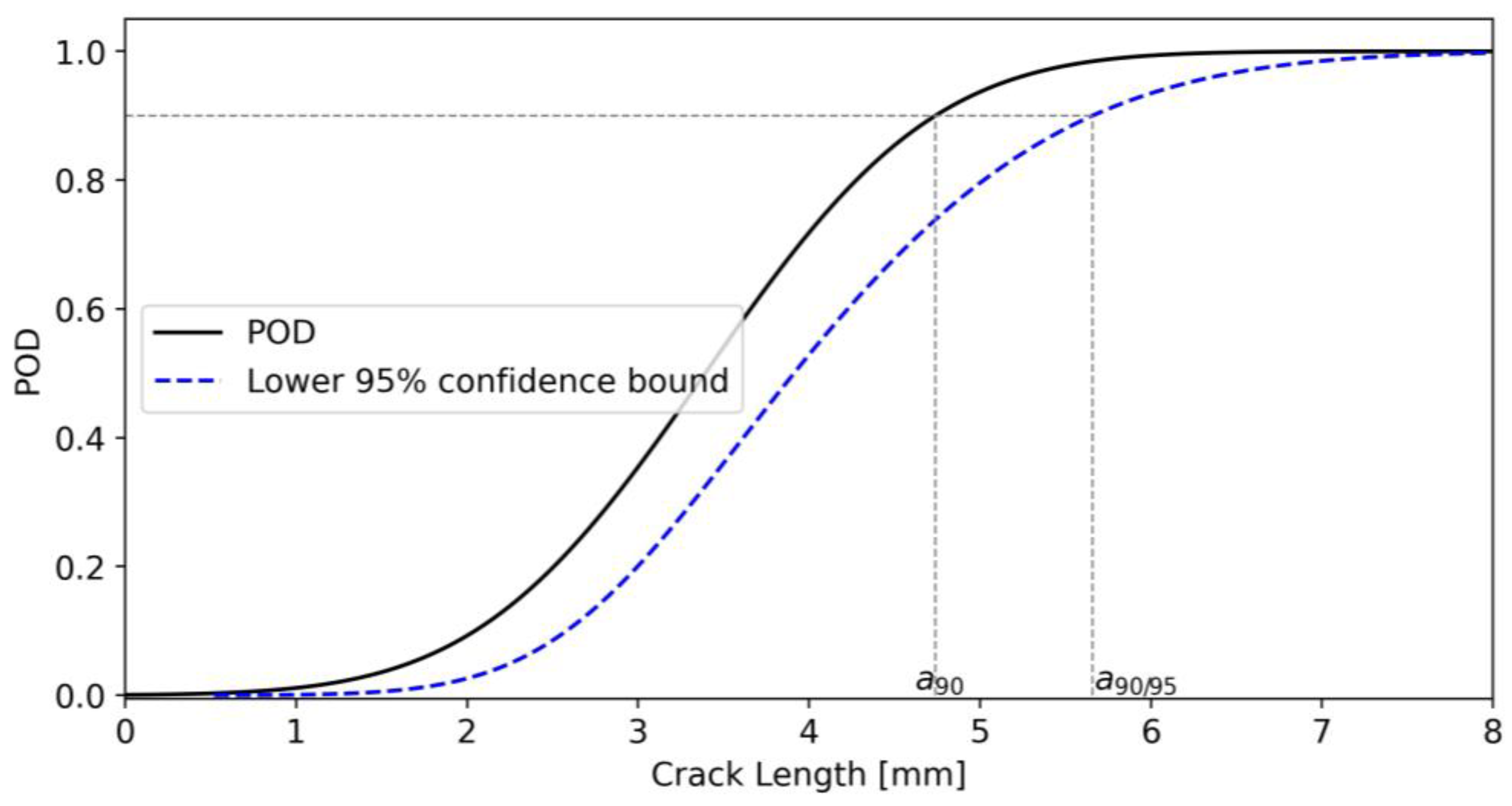



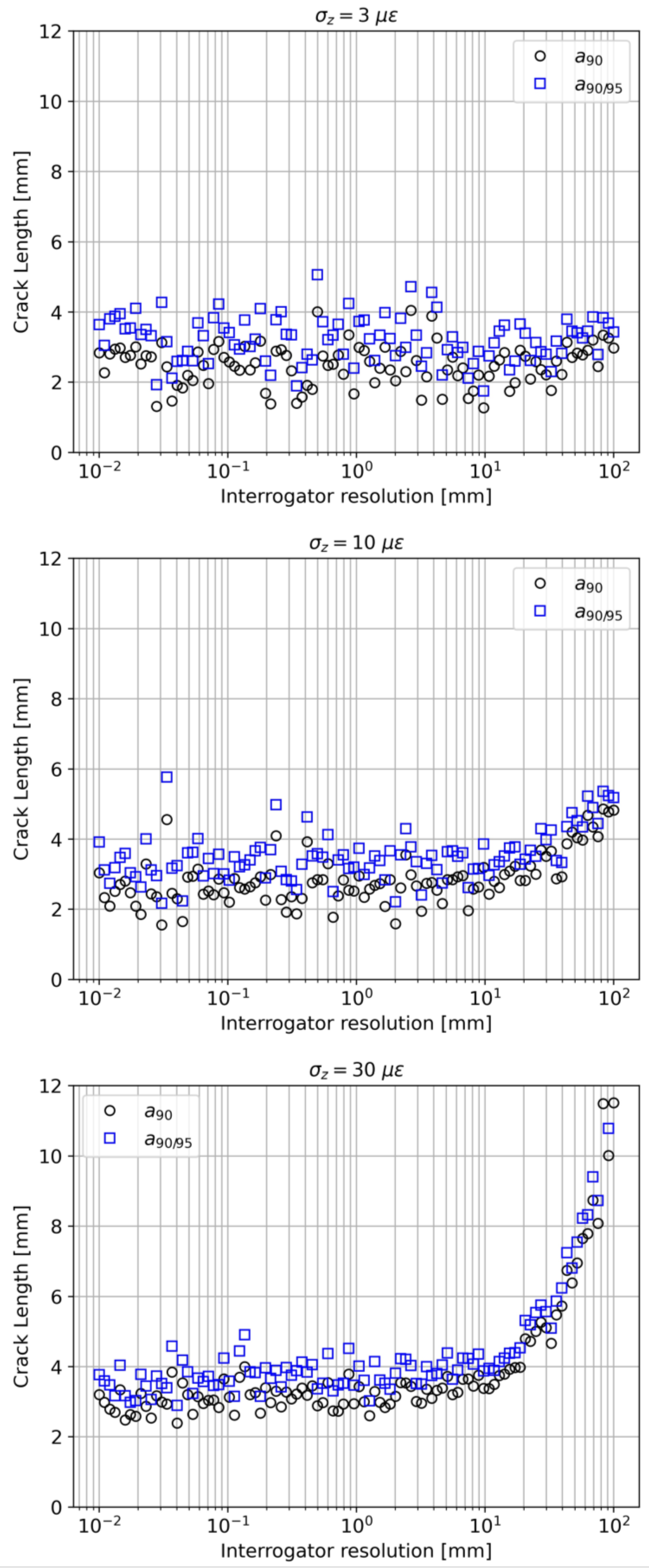
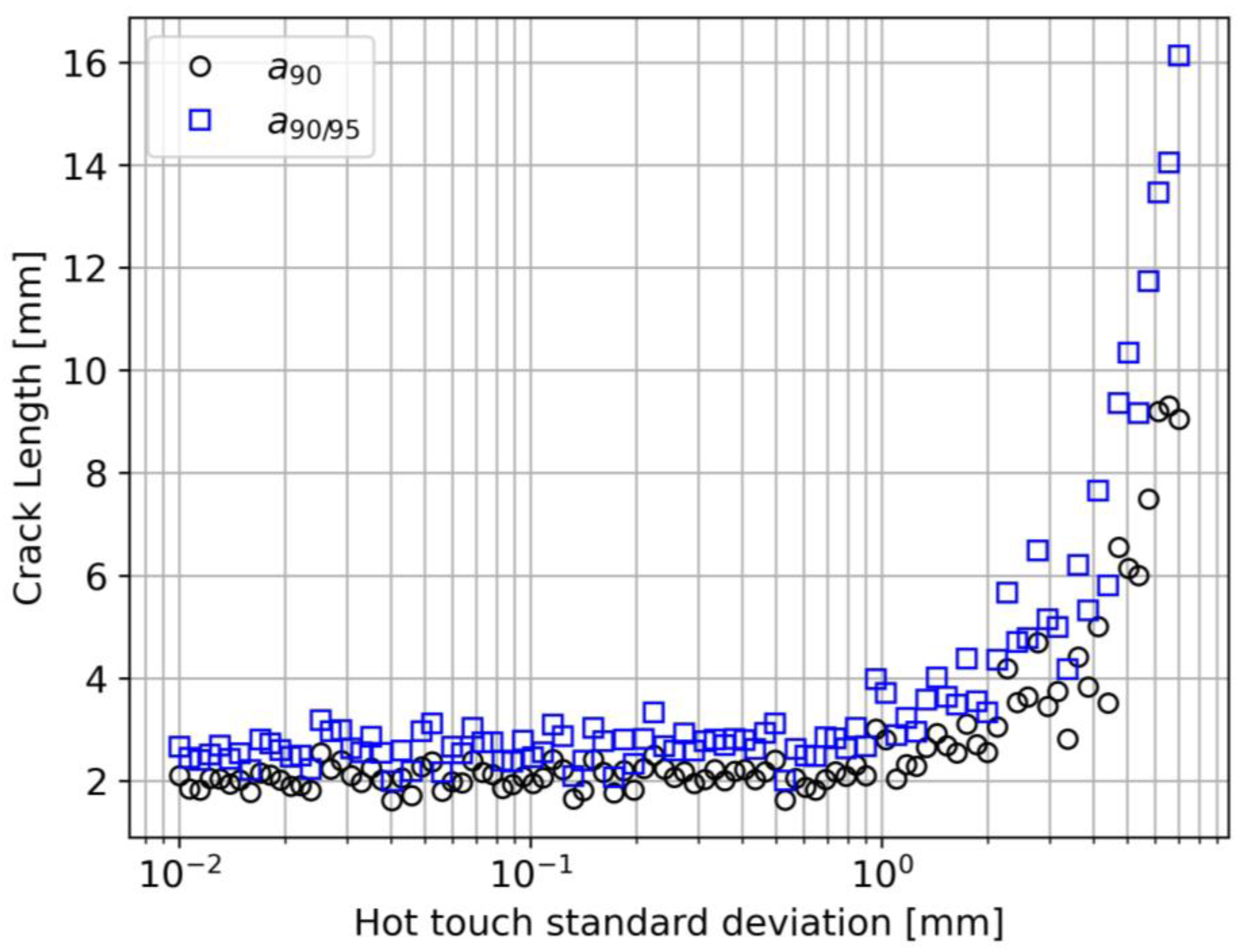

| Variable | Value | Within-Specimen Variability | Between-Specimen Variability |
|---|---|---|---|
| 13 | No | No | |
| 135 | No | No | |
| 2.4 | No | No | |
| 25 | No | No | |
| 20 | No | No | |
| 35 | No | No | |
| 48 | No | No | |
| 0.05 | Yes | No | |
| 3 | Yes | No | |
| 1.7 | No | Yes | |
| 0.17 | No | Yes | |
| 0.65 | No | No | |
| 1 | No | Yes | |
| 0.5 | No | Yes |
| Variable | Experiment | MAPOD | Relative Error (%) |
|---|---|---|---|
| 13 | 13 | ||
| 4.93 | 4.74 | ||
| 5.56 | 5.66 |
| Variable | Case 1 | Case 2 | Case 3 | Case 4 | Case 5 |
|---|---|---|---|---|---|
| 20 | 20 | 20 | 20 | 20 | |
| 135 | 135 | 135 | 135 | 135 | |
| 2.4 | 2.4 | 2.4 | 2.4 | 2.4 | |
| 25 | 25 | 25 | 25 | 25 | |
| 20 | 20 | 20 | 20 | 20 | |
| 35 | 35 | 35 | 35 | 35 | |
| 48 | 48 | 48 | 48 | 48 | |
| 0.05 | 0.05 | 0.05 | 0.05 | 0.05 | |
| 3 | 3 | 3 | |||
| 1.7 | 1.7 | 1.7 | 1.7 | ||
| 0.17 | 0.17 | 0.17 | 0.17 | 0.17 | |
| 0.65 | 0.65 | 0.65 | 0.65 | ||
| 1 | 1 | 1 | 1 | ||
| 0.5 | 0.5 | 0.5 | 0.5 |
| Condition | |||||
|---|---|---|---|---|---|
| 117.4 | 7.2 | [>100, >100, 92.4] | 5.1 | 2.7 | |
| 49.9 | 0.9 | [>100, 41.1, 13.5] | 0.9 | 0.3 |
Disclaimer/Publisher’s Note: The statements, opinions and data contained in all publications are solely those of the individual author(s) and contributor(s) and not of MDPI and/or the editor(s). MDPI and/or the editor(s) disclaim responsibility for any injury to people or property resulting from any ideas, methods, instructions or products referred to in the content. |
© 2023 by the authors. Licensee MDPI, Basel, Switzerland. This article is an open access article distributed under the terms and conditions of the Creative Commons Attribution (CC BY) license (https://creativecommons.org/licenses/by/4.0/).
Share and Cite
Falcetelli, F.; Yue, N.; Rossi, L.; Bolognini, G.; Bastianini, F.; Zarouchas, D.; Di Sante, R. A Model-Assisted Probability of Detection Framework for Optical Fiber Sensors. Sensors 2023, 23, 4813. https://doi.org/10.3390/s23104813
Falcetelli F, Yue N, Rossi L, Bolognini G, Bastianini F, Zarouchas D, Di Sante R. A Model-Assisted Probability of Detection Framework for Optical Fiber Sensors. Sensors. 2023; 23(10):4813. https://doi.org/10.3390/s23104813
Chicago/Turabian StyleFalcetelli, Francesco, Nan Yue, Leonardo Rossi, Gabriele Bolognini, Filippo Bastianini, Dimitrios Zarouchas, and Raffaella Di Sante. 2023. "A Model-Assisted Probability of Detection Framework for Optical Fiber Sensors" Sensors 23, no. 10: 4813. https://doi.org/10.3390/s23104813
APA StyleFalcetelli, F., Yue, N., Rossi, L., Bolognini, G., Bastianini, F., Zarouchas, D., & Di Sante, R. (2023). A Model-Assisted Probability of Detection Framework for Optical Fiber Sensors. Sensors, 23(10), 4813. https://doi.org/10.3390/s23104813











